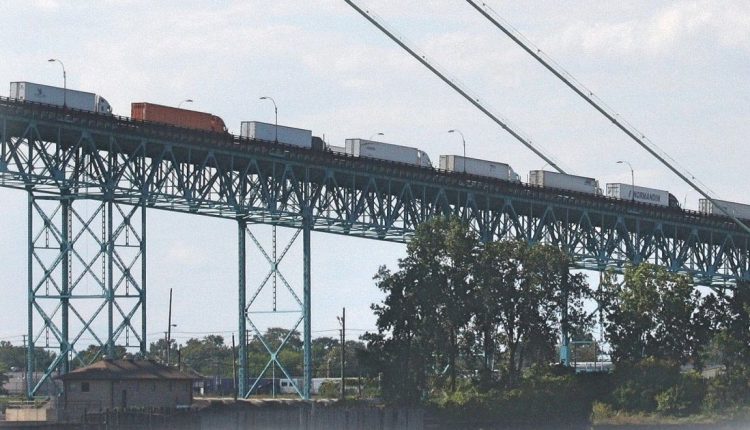The February blockade of the Ambassador Bridge that connects Windsor, Ontario, with Detroit exposed the vulnerabilities of Canada’s supply chain, although it could be months before the federal and provincial governments enact measures that prevent a repeat. In the meantime, the auto industry remains vulnerable when it can ill afford another disruption.
Brian Kingston, president of the Canadian Vehicle Manufacturers’ Association, described the blockade as a “one-off event” but said it should serve as a wake-up call.
“We have to be very careful about [the] image that global investors have of Canada, and we need to be more serious about protecting our trade infrastructure,” said Kingston, whose organization represents the Detroit 3 in Canada.
Currently, governments in Ottawa and Queen’s Park are discussing, but not currently implementing, permanent protections for trade routes.
Taking the necessary steps to make the country’s key transportation corridors more “resilient and reliable” will prevent future disruptions, Kingston said.
Along with the blockade — which all but halted cross-border trade between Detroit and Windsor in early February — he said the 2020 strike at the Port of Montreal exposed another vulnerable chokepoint as the movement of goods in and out of the port ceased.
Likewise, Flavio Volpe, president of the Automotive Parts Manufacturers’ Association, said he is looking for clarity from Ottawa on how the federal government will prevent the takeover of critical infrastructure in the future. The blockade in Windsor provided authorities several effective tactics.
“In Canada, we have our fair share of people who are radicalized in anti-government actions and behaviours, but we’ve got now a body of work in how to handle them,” Volpe said. He estimated that the bridge blockade cost the auto industry $1 billion.
Quick action comforting
As the blockade dragged into its fourth day on Feb. 11, the Ontario Superior Court of Justice granted an injunction filed by the APMA that led to police clearing protesters blockading the base of the Ambassador Bridge.
The 10-day injunction was renewed indefinitely Feb. 18, with the City of Windsor and Ontario governments stepping in to lead the legal effort in place of the APMA.
“There is some comfort for those of us who are pushing freight that it isn’t up to the APMA to continuously seek renewals and a court order [to] ensure that channel remains open,” Volpe said. “It’s actually levels of authority to whom law enforcement answers.”
The federal and provincial governments also declared emergencies in February to give law enforcement special powers to deal with the blockades. Those emergencies have since been terminated.
Hannah Jensen, a spokeswoman for the Ontario ministry of the solicitor general, confirmed that the province is working on permanent steps to ensure trade corridors stay open but would not share any details.
“The government is considering a suite of measures to help police protect Ontarians and the critical infrastructure they rely on,” Jensen wrote in an email.
‘Taking stock,’ taking action
In February, Ontario Solicitor General Sylvia Jones said new regulations to prevent people from blocking public roads would be tackled in the spring legislative session.
Federally, Transport Canada spokeswoman Sau Sau Liu said Ottawa is “taking stock” of gaps “to better protect critical trade and transportation infrastructure from damage or interference caused by blockades, protests or similar activities.”
“Resilient and efficient supply chains are not only critical to ensuring the competitiveness of Canadian businesses but also for the daily lives of Canadians,” Liu wrote in an emailed statement to Automotive News Canada, without referencing measures the federal government is taking to prevent future blockades.
The federal response, she said, would build off an ongoing supply chain assessment, created as a result of serious flooding in British Columbia last fall that severed rail and road links east of Vancouver. Ottawa has created a Supply Chain Task Force that will consult with regional and industry groups on shortand long-term actions.
Dennis Darby, CEO of Canadian Manufacturers and Exporters, said the trade group has begun working with Ottawa on addressing supply chain issues stemming from the blockade, but no measures have been put in place.
“We’re encouraged by the federal government’s willingness to at least begin those conversations, but we certainly haven’t made any progress yet.”
A bridge to a solution
Along with steps to prevent more blockades, the auto sector is looking to infrastructure improvements to smooth out trade corridors.
Here, the federal government is poised to deliver.
The federally owned Gordie Howe International Bridge, rising just downstream from the Ambassador Bridge, is one example. The $5.7-billion project is a little more than halfway through its scheduled construction timeline and is set to open by the end of 2024.
Ottawa has also committed $4.2 billion over 11 years to a fund aimed at relieving congestion along trade corridors.
Rob Wildeboer, executive chairman of Martinrea International Inc., said the Gordie Howe bridge will help the company operate more easily cross-border.
“I think we’ve got to run our business like there’s no border,” Wildeboer said. “And we have to get very close to our American friends because, quite frankly, we’re aligned on a lot of different stuff.”
Citing trade tensions simmering over rising U.S. protectionism, Wildeboer said, “We have got to learn that we are each other’s best friend.”


